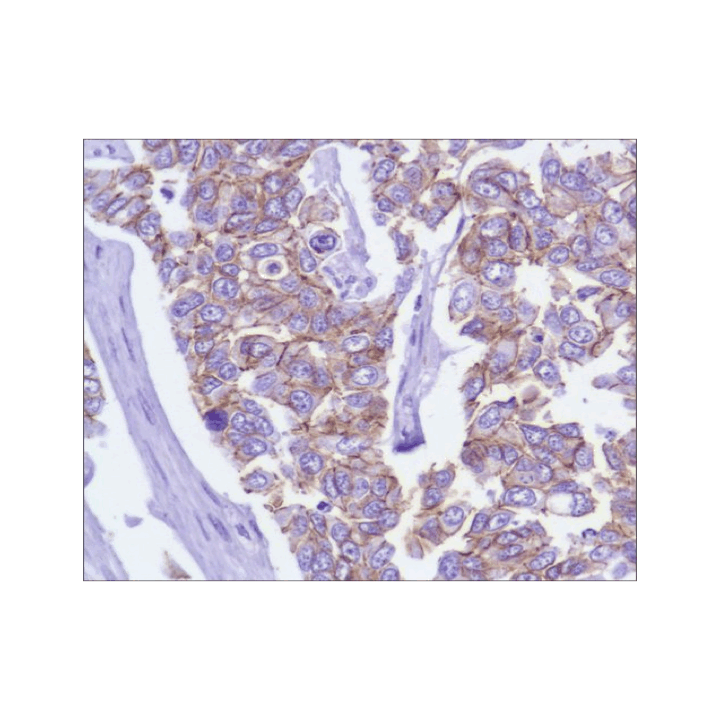Anti-p120 Catenin: Rabbit p120 Catenin Antibody |
 |
BACKGROUND p120-catenin (p120) is the prototypic and most abundant member of an Arm-domain protein subfamily that includes ARVCF, delta-catenin, and p0071 and the more distantly related plakophillins. p120 was originally described as a substrate for Src- and receptor tyrosine kinases, and later was identified as a catenin. p120 is a distant relative of beta-catenin, sharing with it a set of protein–protein interaction motifs known as Arm repeats. p120 associates with most (if not all) classical (type I) and nonclassical (type II) cadherins via p120 Arm repeats 1–7 and the juxtamembrane domain (JMD) of the cadherin cytoplasmic tail. The importance of the interaction is to regulate cell–cell adhesion by modulating events such as cadherin clustering and the strength of the cadherin connection with the actin cytoskeleton. New evidence indicates that p120 regulates cadherin turnover at the cell surface, thereby controlling the amount of cadherin available for cell–cell adhesion. This function is necessary but not sufficient to promote strong adhesion, which is further controlled by signals acting on the amino-terminal p120 regulatory domain. p120 also modulates the activities of RhoA, Rac, and Cdc42, suggesting that along with other Src substrates, p120 regulates actin dynamics. Thus, p120 is a master regulator of cadherin abundance and activity, and likely participates in regulating the balance between adhesive and motile cellular phenotypes.1 In addition, similarly to beta-catenin, it can be detected in the nucleus where it interacts with the transcriptional factor Kaiso. Studies performed in Xenopus have demonstrated that association of p120-catenin relieves the repression caused by Kaiso on Wnt signaling.2
The roles of p120 in regulating adhesion are probably controlled by phosphorylation. To date, 16 phosphorylation sites have been identified, eight on tyrosine and eight on serine or threonine. p120 serine phosphorylation is modulated by events that regulate protein kinase C (PKC) and has been implicated as a negative regulator of adhesion. p120 tyrosine phosphorylation is elevated in nascent junctions, suggesting that p120 phosphorylation may be involved in junction formation or maturation. Although p120 is an excellent substrate for Src family kinases, many other tyrosine kinases can phosphorylated p120 too. Tyr228 was a major target of EGF. Phosphorylation at this site is constitutively elevated in many carcinoma cell lines and it promotes a better affinity of p120-catenin towards RhoA.3
REFERENCES
1. Davis, J.A. et al: J. Cell. Sci. 163:525-34, 2003
2. Park, J.I. et al: Dev. Cell 8:843-54, 2005
3. Castano, J. et al: Mol. Cell. Biol. 27:1745-57, 2007
2. Park, J.I. et al: Dev. Cell 8:843-54, 2005
3. Castano, J. et al: Mol. Cell. Biol. 27:1745-57, 2007
Products are for research use only. They are not intended for human, animal, or diagnostic applications.
Параметры
Contact Us Regarding This Antibody
Cat.No.: | CG1368 |
Antigen: | Synthetic peptide from C-terminus of human p120. |
Isotype: | Rabbit IgG |
Species & predicted species cross- reactivity ( ): | Human |
Applications & Suggested starting dilutions:* | WB 1: IP 1: IHC 1: ICC 1: FACS 1:X |
Predicted Molecular Weight of protein: | X kDa |
Specificity/Sensitivity: | Detects endogenous p120 Catenin proteins without cross-reactivity with other family members. |
Storage: | Store at -20°C, 4°C for frequent use. Avoid repeated freeze-thaw cycles. |
*Optimal working dilutions must be determined by end user.
Информация представлена исключительно в ознакомительных целях и ни при каких условиях не является публичной офертой








